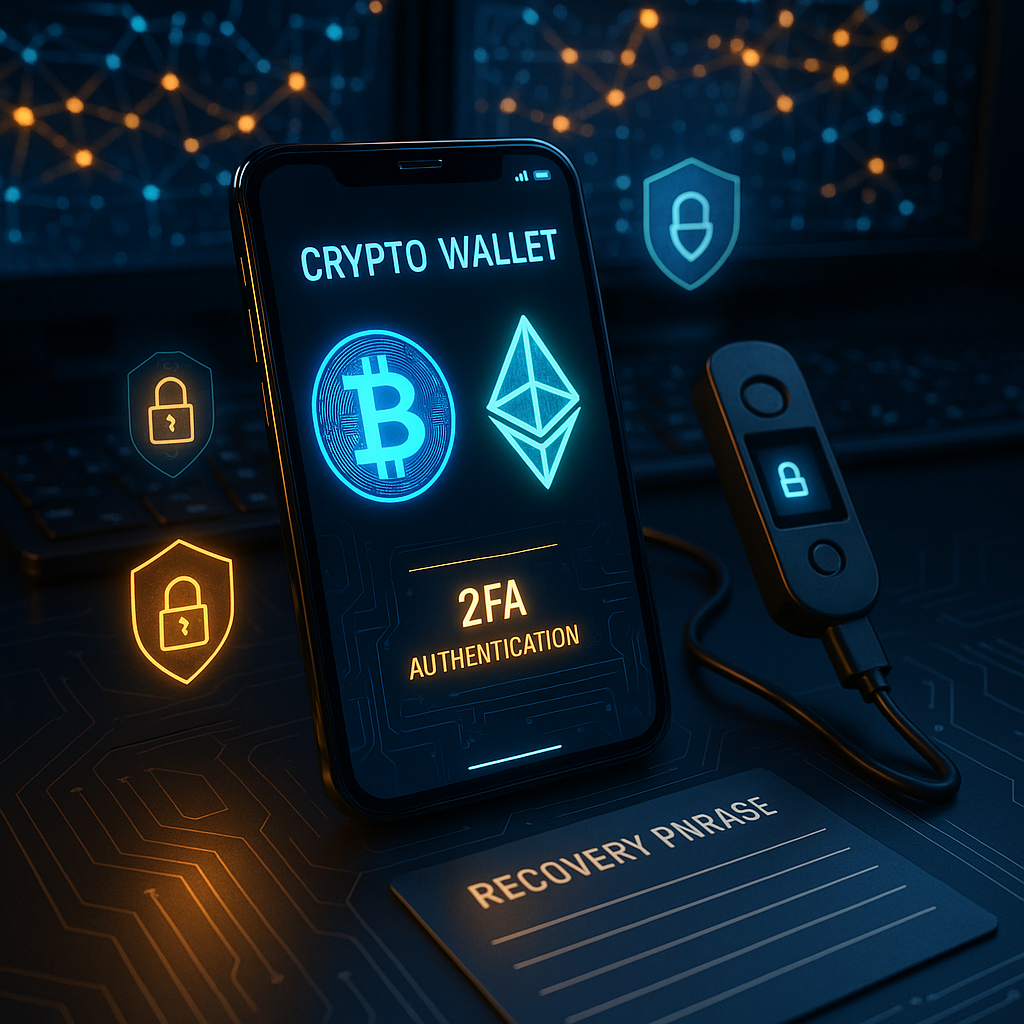Key Takeaways
- Demystify crypto with plain-language explanations: Break down the jargon to gain a real understanding of what cryptocurrency is, how blockchain technology works, and why these innovations matter for achieving financial freedom and digital ownership.
- Begin with simple, low-risk actions: Start your crypto journey by taking manageable steps, such as opening your first digital wallet or exploring reputable exchanges, rather than jumping straight into high-stakes investments.
- Choose your crypto wallet and exchange wisely: Understand the differences between wallet types (hardware versus software) and recognize the critical factors that make an exchange trustworthy. Prioritize security from the very beginning to safeguard your assets.
- Follow a clear, step-by-step path to your first crypto purchase: Benefit from actionable guidance on setting up an account, verifying your identity, selecting your first coin, and making your initial purchase with confidence and minimal guesswork.
- Adopt essential security habits: Empower yourself with practical strategies for protecting your digital wallet, such as using two-factor authentication, creating strong passwords, and steering clear of common beginner mistakes that may lead to loss.
- Build confidence gradually, avoiding overwhelm: Focus on small wins and foundational knowledge to prevent decision paralysis and steadily increase your comfort navigating the crypto landscape, one step at a time.
- Understand both opportunities and risks: Receive an honest, balanced perspective on what to expect as a newcomer, from the basics of investing and security to the realities of volatility and sustainable growth in crypto.
Are you ready to turn confusion into clarity? Let’s embark on your crypto journey together, uncover the building blocks of blockchain, and help you take secure, confident steps into the future of finance.
Introduction
Buying your first cryptocurrency does not have to feel like stepping into a maze filled with jargon and risk. While blockchain technology is often perceived as complicated, its fundamental purpose is to return genuine ownership and financial control to individuals who know how to access it.
This beginner’s guide to cryptocurrency strips away the confusion, providing a clear roadmap through blockchain essentials and each step required to buy crypto safely. You will gain foundational knowledge, discover low-risk ways to begin, and learn the essential security habits that safeguard your assets. The goal is to help you move from uncertainty to confidence, building your skills with every action you take.
Let’s explore how you can take secure initial steps into crypto, understand what truly matters, and lay a solid foundation for your digital future.
Stay Sharp. Stay Ahead.
Join our Telegram Group for exclusive content, real insights,
engage with us and other members and get access to
insider updates, early news and top insights.
 Join the Group
Join the Group
Understanding Blockchain Fundamentals
What is Blockchain Technology?
At its core, a blockchain is a type of digital ledger. It’s an unchangeable, transparent record of transactions that everyone can see but no one can secretly alter. Much like a traditional ledger keeps track of financial entries, a blockchain logs digital transactions across a distributed network of computers. Every new transaction is grouped into a “block” and connected in sequence with the previous blocks, forming a permanent, verifiable chain of data.
To visualize this, picture a shared Google spreadsheet that tracks lunch orders in an office. Once someone places an order, any changes are visible to everyone, making it difficult to cheat or erase entries without detection. Blockchain operates on a similar principle, but with far more advanced security and automation.
The true innovation of blockchain is its decentralized architecture. Instead of central ownership or control, thousands of computers (nodes) around the world operate identical copies of the blockchain. This widespread distribution ensures that no single entity can manipulate the records, enhancing security and trust.
Blockchain is not only the backbone of cryptocurrencies, but it also finds application in other domains, such as supply chain management, digital identity verification in healthcare, voting systems in government, and intellectual property tracking in creative industries.
Types of Cryptocurrencies
The world of cryptocurrency is vast and ever-evolving, with options that reach far beyond Bitcoin. Here are the primary categories you will encounter:
- Bitcoin (BTC): The original cryptocurrency, often referred to as “digital gold” for its store-of-value properties.
- Ethereum (ETH): More than a digital currency, Ethereum supports smart contracts and decentralized applications, making it the backbone for much of the Web3 ecosystem.
- Stablecoins: Cryptocurrencies such as USDC or USDT, designed to maintain a consistent value by being pegged to fiat currencies like the US dollar. These offer stability, especially for those wary of market fluctuations.
- Altcoins: A category that includes a variety of alternative cryptocurrencies such as Cardano, Solana, and Polkadot. Each brings unique features and use cases, from faster transactions to enhanced privacy or novel consensus mechanisms.
As a newcomer, it is wise to focus initially on established cryptocurrencies with strong security and proven track records. Bitcoin and Ethereum collectively represent over 60% of the entire cryptocurrency market, making them suitable starting points for beginners.
Getting Started with Digital Wallets
Types of Crypto Wallets
A cryptocurrency wallet serves as your personal gateway to owning and managing crypto assets. It essentially functions like a highly secure digital bank account. There are two main categories to understand, each with specific advantages:
- Hot Wallets (Connected to the Internet)
- Mobile wallets: Smartphone apps such as Coinbase Wallet or Trust Wallet offer portability and convenience for everyday transactions.
- Desktop wallets: Computer-based wallets like Exodus provide additional control, often with intuitive interfaces for portfolio tracking.
- Web wallets: Browser-based solutions offer quick access but may carry higher risks due to constant internet connectivity.
- Cold Wallets (Offline Storage)
- Hardware wallets: Physical devices such as Ledger or Trezor store your private keys securely offline, offering top-tier security for long-term storage.
- Paper wallets: A physical printout containing your private keys and addresses. These require careful handling to avoid loss or damage.
For those just starting out, reputable mobile wallets strike a good balance between convenience and security. As your crypto portfolio grows, upgrading to a hardware wallet becomes a smart step for reinforcing your long-term security.
Setting Up Your First Wallet
Setting up your first crypto wallet is easier than it seems if you follow these straightforward steps:
- Choose a Trusted Wallet Provider
- Research well-established options such as Coinbase Wallet or Trust Wallet.
- Examine recent user reviews and look for strong security histories.
- Ensure the wallet supports the specific cryptocurrencies you intend to use.
- Download and Install Securely
- Always download wallet apps from official app stores or verified websites.
- Double-check the authenticity of the developer or vendor before proceeding.
- Avoid downloading or updating through unofficial links or sources.
- Safeguard Your Recovery Phrase
- On setup, your wallet will generate a 12–24 word recovery phrase. This is the master key to your crypto holdings.
- Write the phrase down and store it in multiple secure locations (such as a safe or a safety deposit box).
- Never share your recovery phrase with anyone and avoid storing it digitally, as this could expose you to hacking risks.
Buying Your First Cryptocurrency
Choosing an Exchange
The right exchange acts as your reliable bridge to the crypto world. When selecting a cryptocurrency exchange, consider the following essential factors:
-
Security Measures
-
Robust two-factor authentication (2FA)
-
Cold storage for most user funds
-
Transparent insurance policies against breaches
-
User Experience
-
Intuitive, user-friendly platforms designed to streamline your first transactions
-
Clear, step-by-step buying processes
-
Responsive, knowledgeable customer support
-
Features and Accessibility
-
Broad range of supported cryptocurrencies for future flexibility
-
Multiple payment methods, including bank transfers and debit cards
-
Availability in your region, with compliance to local regulations
Leading beginner-friendly exchanges include Coinbase, Gemini, Kraken, and others that prioritize both security and education. Many now offer learning modules and simulation modes to help new users practice trading before risking actual funds.
In addition to personal finance, regulated crypto exchanges are finding applications in sectors such as cross-border remittances (making international transfers faster and cheaper), charity fundraising (using transparent, trackable crypto donations), and even small business operations (allowing global, 24/7 payments).
Step-by-Step Purchase Guide
Making your first cryptocurrency purchase is a structured, straightforward process:
- Create and Secure Your Exchange Account
- Complete the registration process with your email address and strong password.
- Provide required identification documents to verify your identity and meet legal requirements.
- Enable two-factor authentication (2FA) to add an extra layer of security.
- Link your preferred payment method (bank account, card, or other available options).
- Deposit Funds into Your Account
- Transfer money from your bank account to the exchange.
- If possible, start with a modest amount to familiarize yourself with the platform’s processes and fees.
- Review deposit fees or processing times, which can vary by provider and region.
- Place Your First Crypto Order
- Navigate to the buying section, select the cryptocurrency you want to purchase (such as Bitcoin or Ethereum), and decide how much you want to buy.
- Choose between market orders (buy at the current price) or limit orders (set your own price target).
- Double-check the transaction details, then confirm your purchase.
Remember, starting with a small investment (like $50 to $100) is common practice for beginners. This approach lets you learn the ropes without undue financial pressure, providing real-life experience before scaling up.
Security Tips and Best Practices
Essential Security Measures
Securing your cryptocurrency requires vigilance and multiple layers of protection:
- Account Security
- Always use unique, complex passwords for exchanges and wallets.
- Enable two-factor authentication (2FA) for added security.
- Never disclose account details to unverified individuals or platforms.
- Device Security
- Keep your operating system and apps up to date to shield against vulnerabilities.
- Install reliable antivirus software and monitor potential threats.
- Use private, secure Wi-Fi connections, especially for sensitive transactions.
- Operational Security
- Verify every transaction detail before confirming, including wallet addresses and transaction amounts.
- Double-check recipient information when sending funds, as crypto transfers are irreversible.
- Never share your private keys or recovery phrases, and avoid storing them online.
Common Scams to Avoid
The explosive growth of cryptocurrency has attracted fraudsters and scammers to every corner of the internet. Stay alert to these prevalent scams:
Stay Sharp. Stay Ahead.
Join our Telegram Group for exclusive content, real insights,
engage with us and other members and get access to
insider updates, early news and top insights.
 Join the Group
Join the Group
- Impersonation Scams: Fraudsters posing as support representatives, celebrities, or well-known industry figures to trick users into giving up account access or sending funds.
- Phishing Attacks: Suspicious emails, fake websites, or social media links designed to collect your login credentials or personal information.
- Ponzi and Investment Schemes: Platforms or individuals promising guaranteed or outsized returns in exchange for your crypto investment. This is an immediate red flag.
- Malicious Apps: Fake wallet or exchange applications that steal user credentials or funds. Always verify app authenticity through official sites.
When faced with an unfamiliar offer or request, remember: if it sounds too good to be true, it almost certainly is. Take time to research and independently verify before taking action.
Risk Management and Investment Strategy
Understanding Market Volatility
The cryptocurrency market is known for rapid, sometimes dramatic price swings. To navigate volatility thoughtfully:
- Start with What You Can Afford
- Only invest money you are prepared to lose without financial hardship.
- Use dollar-cost averaging (consistently purchasing small amounts over time) to smooth out volatility and avoid emotional buying or selling.
- Maintain realistic expectations. Focus on learning and long-term perspective, not quick riches.
- Diversify Your Portfolio
- Spread investments across multiple cryptocurrencies instead of concentrating on a single option.
- Consider diversification into stablecoins or other digital assets to lower exposure to volatility.
- Balance risk with your personal goals and risk tolerance.
Crypto volatility is not unique to this market. Other industries, such as equities, commodities, and even real estate, experience variations influenced by different factors. Understanding and applying disciplined strategies is valuable across all investment domains.
Tax Considerations
Cryptocurrency taxation varies worldwide, but most regulators classify crypto transactions as taxable events. Key points to keep in mind include:
-
Taxable Events:
-
Selling cryptocurrency for traditional currency (such as US dollars, euros, etc.).
-
Exchanging one cryptocurrency for another (like trading Bitcoin for Ethereum).
-
Using cryptocurrency to purchase goods or services.
-
Record-Keeping Best Practices:
-
Maintain detailed records for every crypto transaction, including purchase prices, transaction dates, and counterparties.
-
Save exchange and wallet statements for end-of-year reporting and audits.
Consulting a qualified tax professional familiar with local regulations ensures compliance and minimizes surprises. For professionals or businesses using crypto in industries such as consulting, e-commerce, or overseas contracting, diligent record-keeping is especially important.
Building Long-Term Success
Sustained success in cryptocurrency hinges on ongoing education, effective risk management, and community engagement:
- Never Stop Learning
- Stay abreast of evolving blockchain technologies, regulatory changes, and market trends.
- Leverage reputable educational resources, such as The Crypto Dojo, industry news sites, and community forums.
- Understand the impact of developments in fields like decentralized finance (DeFi), NFTs, and blockchain’s adoption in sectors like healthcare and logistics.
- Practice Consistent Risk Management
- Define your investment objectives and establish clear parameters for profit-taking or cutting losses.
- Set realistic stop-loss targets to manage downside risk.
- Schedule regular portfolio reviews to assess progress and make thoughtful adjustments.
- Engage with the Crypto Community
- Join discussion groups (e.g., Discord, Reddit, Telegram) to swap stories, tips, and new findings.
- Participate in online events, webinars, or meetups to deepen your understanding and network.
- Share your learnings with others, reinforcing your own knowledge and confidence.
Remember, success in cryptocurrency (like any investment or new skill) is a marathon, not a sprint. Through steady knowledge-building and disciplined security, you position yourself for progress and growth over time.
Conclusion
Mastering cryptocurrency begins by understanding blockchain’s transparent, decentralized foundation. Next, it’s about navigating wallet choices, exchanges, and digital asset security step by step. Prioritizing small, secure actions, remaining vigilant against scams, and gradually building knowledge are the practices that transform uncertainty into lasting confidence.
Importantly, sustainable progress in crypto comes not from chasing hype or rapid wins, but from resilience, curiosity, and practical learning. The most successful participants in this digital frontier are those who learn, earn, and repeat. They grow steadily as the landscape evolves.
Looking to the future, those who embrace foundational knowledge and responsible practices will lead the way as blockchain, DeFi, and digital assets reshape both personal finance and industries at large. Every confident step you take now builds toward greater autonomy and opportunity in a new, decentralized economy.
Your journey starts here. Take your next step, keep learning, and become part of the next generation of empowered crypto explorers.





Leave a Reply